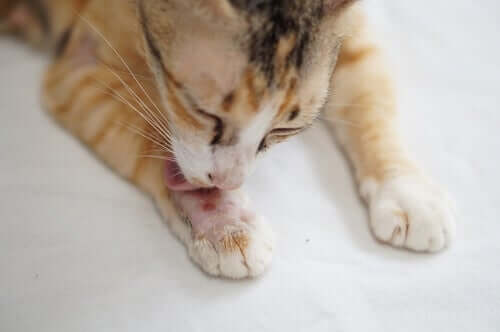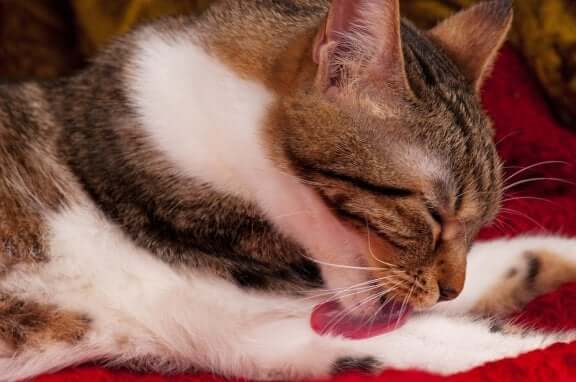Which Changes in Your Cat's Fur Should You Pay Attention To?

A cat’s fur can vary greatly between different breeds. There are cats with long, medium, or short fur, but they all shed their fur naturally. Normally, their fur is thicker during the winter than in summer, so it changes during spring and autumn.
Air conditioning and heating in the home can, therefore, influence how much your dog or cat molts. Most houses are kept at a constant temperature throughout the year, so some pets don’t seem to molt at one time of year, but instead molt constantly throughout the year.
Abnormal changes in cat fur
Skin problems are one of the most common reasons that cat owners visit the vet because they’re easy for the owner to recognize.

Alopecia
This is a very striking condition, particularly if it develops quickly. Baldness or a lack of hair in certain areas can be caused by a variety of things. The most common are:
- Endocrine disorders. Baldness caused by this type of condition has a specific pattern. It usually only occurs on certain areas of the body or is symmetrical.
- Allergies. An allergic reaction to food or something in the environment can cause itching. Obviously, to relieve the itching, the cat licks itself which, in turn, pulls out hair.
- Feline miliary dermatitis. This is hypersensitivity to environmental allergens, external parasites, infections or autoimmune reactions. It can cause itching and skin lesions distributed around the neck, chin, and back.
- Parasites. Scabies and ringworm can cause a lot of itching. Scabies is caused by mites and ringworm is caused by a fungus. Round bald patches are common.
- Leishmaniasis. Leishmaniasis is also a parasitic disease. It’s much less common in cats than in dogs, but if your cat’s immune system is compromised, they can still get infected. It’s common for skin lesions and subcutaneous nodules to appear on the head and legs.
- Stress. Excessive grooming can be a clear sign of stress and may lead to bald patches.
- Pain. Cats with joint pain sometimes pull or lick the hair over the affected area.

Hair loss
If the problem is excessive molting, dandruff, or greasy fur, the problem could be hormonal or nutritional. If there are no other symptoms and blood tests rule out any serious diseases, then better nutrition and more fatty acids can help resolve the problem.
What do I do if I notice a problem with my cat’s fur?
As you can see, there are many things that might be wrong with your cat’s fur, so if you notice any bald patches, lesions, or lumps, you should go straight to the vet.
Once there, the vet will carry out a series of tests to try and rule out the most serious diseases. In some cases, it may be necessary to carry out a blood test to check that all their organs are working properly.
If your vet confirms some type of disease, you should start treatment as soon as possible. Normally, if treated properly, skin and hair problems will clear up and disappear.
If the problem is just a skin problem caused by an allergy or nutritional problem, then the skin will heal once the cause is eliminated and the hair will start to grow back. You can help speed this up with some kind of nutritional supplement as long as your vet agrees.
It’s a similar scenario if stress is causing the problem. You’ll have to find out what has changed in your cat’s life and try to address their increased stress or lack of stimulation at home.
All cited sources were thoroughly reviewed by our team to ensure their quality, reliability, currency, and validity. The bibliography of this article was considered reliable and of academic or scientific accuracy.
- LOWELL, A.Atlas de Dermatología en Pequeños Animales. Buenos Ai-res, Intermedica, 2008.
- Affinity-petcare. Leishmaniasis en gatos. Síntomas, diagnóstico y tratamiento.
- Affinity-petcare. Dermatitis en gatos: Dermatitis miliar felina, posibles causas.